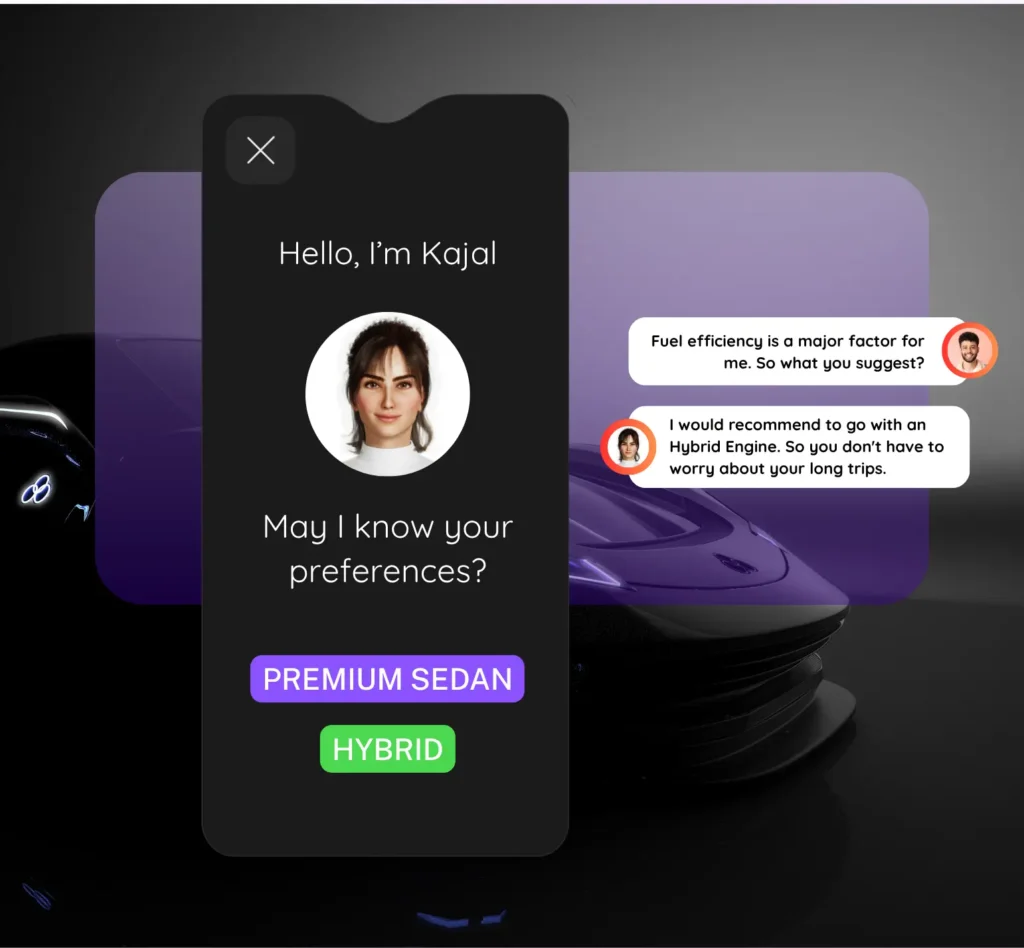Metaverse is an innovation that has entered the business world with the purpose of helping brands simplify sales processes and enhance the quality of customer experiences.
“Investment in Metaverse is going to be a key for your organization in this financial year. But just like any investment, you need to consider the risks and rewards and invest in the right strategy and the right amount for your organization. What works for one company may not work for another.”– Dr Ananth, Co-founder & CTO – DaveAI
With so many things being said about the Metaverse today, we at DaveAI have curated a guide for all the businesses out there; ready to enter the new domain. Having been created by considering the experiences the DaveAI team came across while formulating Metaverse strategies for renowned brands in different industries, this guide aims to help businesses consider important strategies, avoid mistakes and burst common myths.
The Metaverse can be a useful tool for brands to drive more sales. But only if the focus is on the customer and brand perception. Many enter this domain with the idea of being a part of the rat race. Metaverse is not a sprint but a marathon where every strategy built with a brand-customer bowl of personalized ideas is a winner.

Virtual showrooms
If you already have a brick-and-mortar store business and are looking to strengthen the digital presence of the brand, a virtual showroom is a great strategy to be considered. A virtual showroom is a digital twin of the actual store that showcases products and product features in an immersive 3D environment to give the customers an easier selection process.
Deploying a virtual shopping experience without a digital sales companion is not advisable. An intelligent sales companion will simplify the sales process by personalizing the stages of awareness for the buyer till the sale is closed. Without this sales agent, there would not be any meaningful interactions between the business and the customer. An intelligent sales companion will also help the business create customer portfolios that can be used to understand buyer preferences and personas.
Product launch
If you have a new product to launch, you can do it in the Metaverse for an increase in customer enquiries and engagement. A Metaverse product launch can create buzz around the brand and its product like no other strategy today. Maruti Suzuki recently launched the Grand Vitara in Nexaverse powered by DaveAI. Within a month of its launch, Nexaverse had more than 30,000 users on the platform with more than 70,000 user interactions. Nexaverse has also influenced 20% of the pre-bookings of Grand Vitara cars for Maruti Suzuki.
A product launch in the Metaverse should not be exclusive to a particular device. For example only VR devices or smartphones. This Metaverse experience should be provided through all possible channels to ensure hardware inclusion and witness a response from a maximum number of people.
Interactive spaces
For businesses wanting to interact with their customers every now and then, an interactive virtual space is the best strategy. What is an interactive virtual space? This space is specifically designed by keeping the essence of the brand in mind and is populated with digital humans for conversations. For instance, if a luxury fashion brand wants to create a personalized space to display handbags and also interact with the customer when needed, a virtual space that matches the vibe of the products can be created and changed as per the catalogue display.
Example: A leather handbag catalogue display can have a rustic look to the space.
An avatar is an important aspect of these interactive spaces. A virtual avatar can be deployed in this space as a digital assistant to talk about the product features when a customer shows interest in any particular one. An avatar can also be deployed in this space as a virtual influencer. In the above scenario, one or more digital models can be deployed to depict the bags in real-life scenarios for a more realistic showcase- matching outfits and all.
Example: Large bags with avatars dressed casually, small bags with avatars dressed formally, an elegant clutch or a miniature bag with avatars dressed in ethnic wear, etc.
An interactive Metaverse experience should not have a digital assistant or an influencer without a voice for a conversation. Voice over text should be preferred for greater engagement from the customer. Also, the digital human should have the ability to converse in the customers’ native or preferred language to avoid any confusion and lack of interest from the user.
Gaming experiences
If you want to advertise your brand and its offerings in a way people remember for a long time a Metaverse gaming experience would do the trick. For example, if it is a beauty brand wanting to promote a new line of lipsticks, a fun activity on a digital platform can be created where, in a virtual space, a virtual influencer is deployed with a lipstick in hand to encourage the user to use the shade. When the user checks the shade on the avatar, appropriate reactions can be given through the facial expressions of the avatar- happy face, sad face, etc. Then the virtual influencer further encourages the user to recommend the product to friends and invite them into the space to try different shades together. Invitation to people can help the user earn reward points that lead to a free delivery of a lipstick shade at home.
Live game streaming experiences should be avoided for advertising. Streaming experiences today are inconsistent due to various influencing factors like network, location, etc and the irregular quality of the experience can interfere with the fun quotient this strategy promises. 5G could prove to be a game changer and is going to be revolutionary for marketing in Metaverse.
Personalized configurations
The brand can launch a product or space configuration feature in the Metaverse where they allow users to customize the features of the space they are in or products as per their preference. For example, if it is a home lifestyle brand in the Metaverse and has a lot of variety in a particular product, let’s say a bed cover set. Then a bed in the virtual store of the brand can be displayed in 3D to allow customers to change the bed cover set from options available to immediately identify what it would look like on the actual product after purchase. This would enable a quick and effective showcase of the entire collection.
The product configuration feature should not be deployed without a recommendation system. The recommendation system should trigger accurate nudges from time to time to articulate a quick process of product discovery.
Brand’s own Metaverse
Nowadays there are many Metaverse platforms that allow the purchase of land, create and deploy games or even host interactions with users. Some of these platforms are powered by web 3.0 while some are not. The difference between Metaverse and Web 3.0? The Metaverse is an immersive space where people can interact with objects in 3D whereas Web 3.0 denotes the next iteration of the Internet where the management of digital assets and services is powered by blockchain technology and the users can create and maintain their own assets.
It is now time for brands to consider creating their own Metaverse platforms instead of sticking to the existing ones for deployment. A brand-specific platform can create personalized user experiences. A brand-specific Metaverse can solve issues like platform consolidation, unavailability of a product launch feature, and high cost. The brand’s own Metaverse- a single, immersive environment designed to cater to the specific needs of the business and its customer helps scale one-to-one relationships, provide assistance to customers while navigating the platform, and also enable cross-selling of products. This high-intent engagement platform can be used by the brand to advertise and sell by deploying different strategies together in one place.
One thing brands should not do is use the Metaverse to run an advertisement that revolves around conveying a message to the audience. As the load time of the Metaverse platform is high, using the Metaverse for single-time ad use is not advisable.
Metaverse is not only about VR
The common misconception about Metaverse is that it is always powered by VR. That is not always the case. Metaverse can also be an application or a webpage where the brands deploy unified, immersive experiences for customers. According to Oberlo, a mobile phone is the most popular device used in the world today. With the ease of use and portability it brings, it is always better to deploy Metaverse experiences for customers on devices they prefer and spend most of their time on. VR devices, as of today, are not easily available for everyone, are not pervasive, and are not comfortable for new users to use. VR device inclusion that ranges from infrastructure to universal access can be seen missing. VR devices are also expensive. Getting engagement from users through VR devices takes time as compared to experiences deployed on other digital platforms.

User Interactions in the Metaverse should not be unrestricted
In the brand-powered Metaverse for customers, the interactions between customers should not be without any environment-friendly user policies in place. The focus should always be on the products and the vision the space wants to depict. So the maximum number of interactions should be between the brand and its customer and vice versa.
Apart from the user, A brand can also use the Metaverse platform for training purposes. For employees, internal interaction policies should allow employees to converse freely with each other to help bring innovation to the table.
Brands will need to make use of the Metaverse to reach up-and-coming customers who are disregarding conventional mediums in favour of gaming and social media platforms. Companies should shun certain misconceptions to avoid mistakes and keep experimenting with the above-mentioned strategies to create a brand presence that is unique and impactful. The starting point should always be the brand perception. Knowing the end result would help create the right kind of engagement. To attract more people brands should ensure that the content provided is bonafide. Ultimately, brands should not wait to see what happens. NOW is the time to act towards the adoption of the Metaverse!



